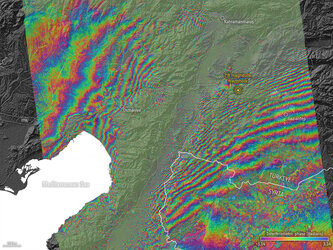

Bam interferogram with 0.6 m baseline
This interferogram is produced by combining two separate radar images of the same scene - in this case the area struck by the Bam earthquake in Iran, acquired December 2003 and February 2004. Combining the images in this way highlights alterations in the scene, with radar backscattered from these features having a different signal phase, manifesting in colourful interference patterns on the combined image known as fringes. These fringes can be used to measure tiny changes in the landscape occurring between images down to a maximum accuracy of a few millimetres, allowing geologists to see where faulting has occurred. For increased accuracy the spacecraft should return to as close as possible to the same point where the first image was taken - known as the baseline. For this acquisition a baseline of just 0.6 metres was achieved, due to very high precision spacecraft navigation.





